Nestled amidst the rolling hills and picturesque countryside of South England lie the timeless treasures of history and grandeur – there are 72 majestic castles that have withstood the test of time. Embarking on a journey to explore these iconic fortresses, from the medieval grandeur of Windsor Castle to the enchanting formal gardens surrounding Arundel Castle, is akin to stepping into a fairy tale, where each castle whispers stories of medieval conquests, royal romances, and architectural marvels. This region, steeped in the legacy of Henry VIII and Queen Victoria, boasts some of the best castles of South England.
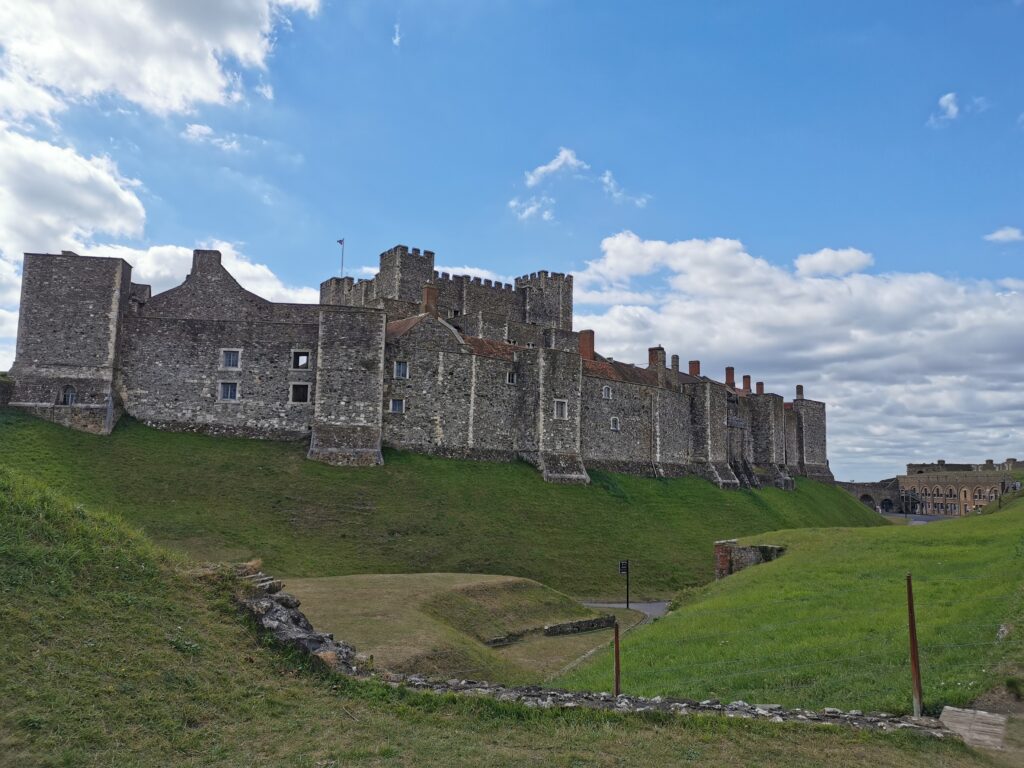
As you wander through these storied castles, you’ll find yourself transported back to the 12th and 13th centuries, an era when chivalry reigned supreme, and nobility held court within formidable Bailey and Norman castles. The allure of these ancient structures lies not only in their breathtaking beauty and their roles as historic houses or country homes but also in their ability to ignite our imagination and curiosity about bygone eras. For instance, the Great Tower of Dover Castle, a Norman stronghold, stands as a symbol of England’s resilience during the Napoleonic Wars and the Norman Conquest.
Join us as we embark on an exploration of the captivating castles of South England, delving into their rich histories, architectural splendour, and enduring cultural significance. From the artillery forts along the rugged coastline to the stately homes nestled in the English countryside, each castle – be it the famous Leeds Castle in Kent, the grand Warwick Castle in the heart of England, or the tranquil Farnham Castle, part of the National Trust – tells a unique story. Discover the medieval baileys, the opulent state apartments, and the breathtaking views that these beautiful castles, like the Bodiam Castle in East Sussex or the Carisbrooke Castle on the Isle of Wight, offer.
Whether you’re planning a short break or a day trip, the castles of South and South West England, from the UNESCO World Heritage Sites to the lesser-known yet equally enchanting Norman strongholds, await to offer you a glimpse into the United Kingdom’s centuries of history. So, pack your bags and set forth on a journey to explore these magnificent castles, where history meets the beauty of the English landscape, creating an unforgettable experience.
Windsor Castle: A Royal Residence Steeped in History
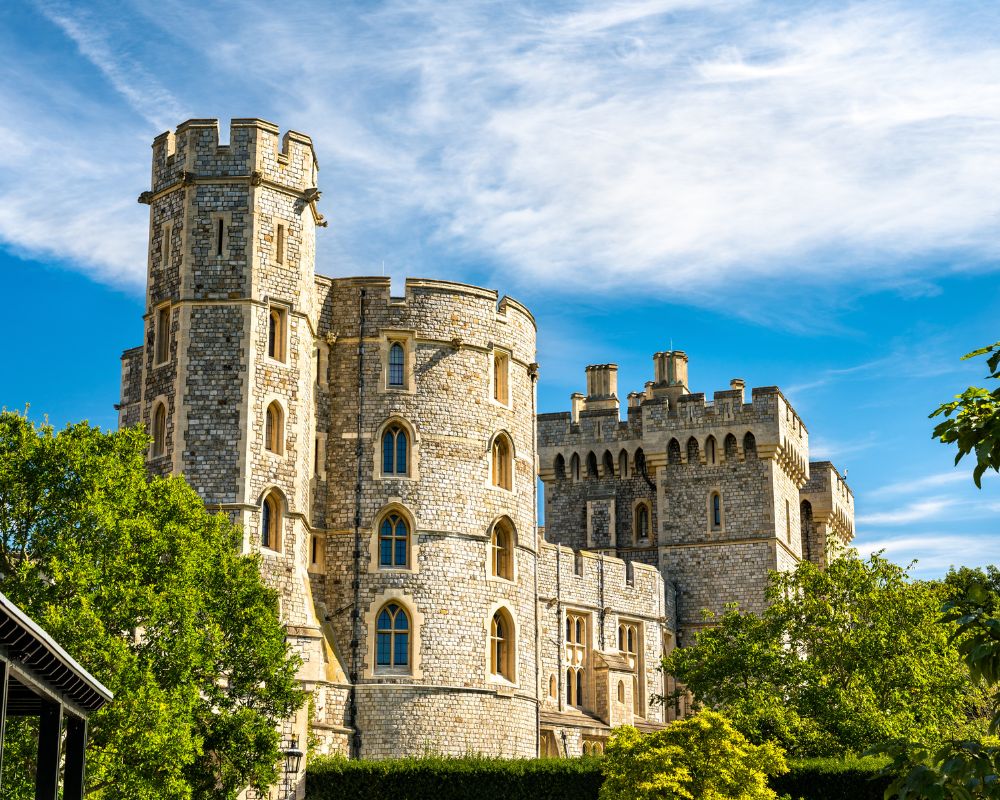
Windsor Castle, perched majestically on a hill overlooking the River Thames in Southern England, epitomizes the grandeur and historical depth of a medieval bailey castle. Known as the oldest and largest occupied castle in the world, its origins trace back to the Norman castle built in the 11th century by William the Conqueror, with significant additions in the 12th and 13th centuries. This architectural marvel, a blend of medieval and Georgian design, stands as a symbol of English heritage, encapsulating over a millennium of British history.
The castle’s structure, including the iconic Round Tower and the opulent State Apartments, reflects the evolution of English royal architecture. The imposing Norman Gate leads visitors into a complex that has been a royal residence and a defensive fortress. Its rich history is intertwined with that of the royal family, from King John’s reign in the early 13th century to its current status as one of Queen Elizabeth II’s favourite residences.
Windsor Castle is not just a monument of the past; it’s a living piece of history. The castle grounds, a fusion of formidable battlements and serene landscaped gardens, evoke the charm of an English country home while still functioning as a stately home and a venue for significant state events. The castle has withstood the challenges of the Middle Ages, the English Civil War, and the modern era, reflecting the resilience and adaptability of the monarchy.
A visit to Windsor Castle offers a journey through the epochs—from the medieval grandeur of its initial construction to the refined elegance of the Victorian era. It’s a rare opportunity to explore a UNESCO World Heritage Site that continues to function as a royal palace and administrative centre. Whether you’re a history enthusiast or simply seeking a glimpse into royal life, Windsor Castle, a top castle and a jewel in the crown of English heritage, invites you on a timeless adventure through the heart of British history.
Arundel Castle: A Medieval Masterpiece
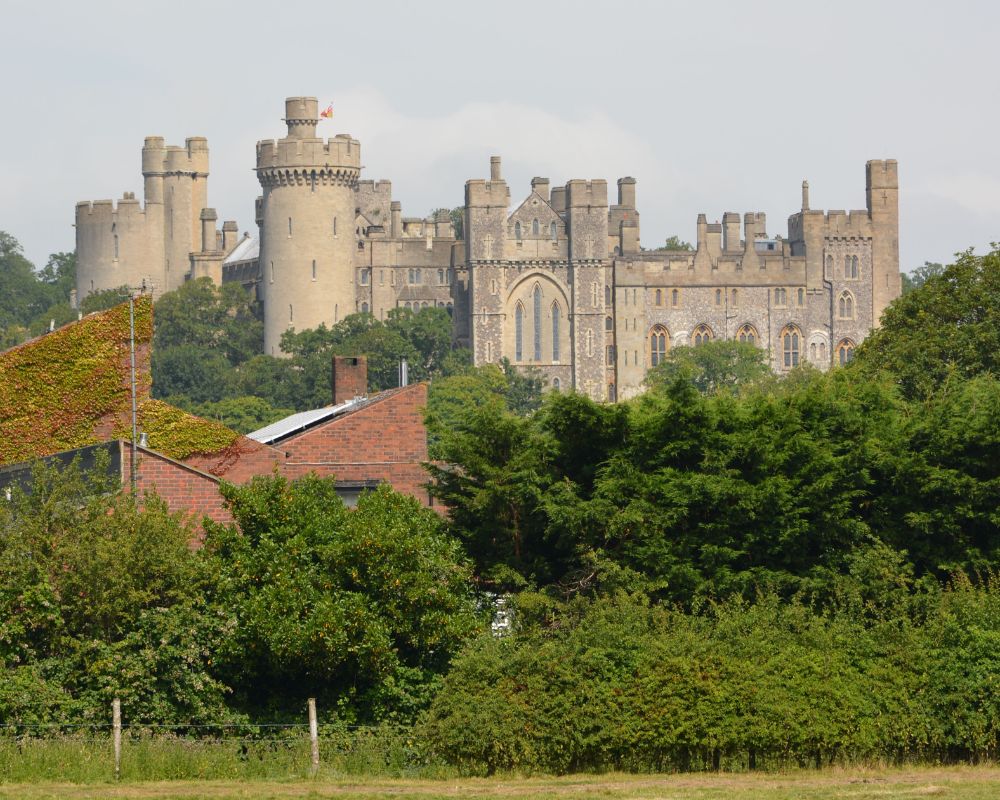
Nestled atop a majestic hill in West Sussex, Arundel Castle not only epitomizes the essence of a medieval castle but also stands as a symbol of England’s rich and varied history. Built in the late 11th century by Roger de Montgomery, a companion of William the Conqueror, this grand castle has been a pivotal player in historical events, from the Holy Roman Empire to the turbulence of the 16th century. It’s a striking example of the transition from a medieval fortress to a luxurious country house.
As you wander through the Great Hall, you are enveloped in an atmosphere that harks back to the 12th century yet echoes the modifications made up until Victorian times. The hall, with its high ceilings adorned with historic carvings and banners, reflects a lineage that intertwines with key figures in English history, such as the Earls of Arundel and the Dukes of Norfolk. The castle’s collection of art and artefacts, ranging from medieval armour to exquisite 18th-century tapestries, offers a tangible connection to the past.
Arundel Castle’s exterior is equally captivating. The meticulously landscaped gardens, designed in part during the Victorian era, are a tranquil haven. The River Arun flows gracefully nearby, adding to the picturesque setting. The gardens are a vibrant tapestry of colour, with beautiful gardens reminiscent of those at Hever Castle or the manicured elegance of those found at Thornbury Castle in the South West of England.
Not just a castle, Arundel has evolved into a quintessential English country house, boasting a rich tapestry of architecture and history. While it’s not a castle hotel like those found in Warwickshire’s Kenilworth Castle or West Yorkshire’s offerings, Arundel offers a glimpse into the life of nobility from the times of the Holy Roman Empire to the present day.
Visiting Arundel Castle is more than a day trip; it’s a journey through the annals of time. From its origins as a medieval fortress and artillery fort to its evolution into a grand castle and stately home, Arundel Castle is a testament to the resilience and adaptability of English heritage. Whether you’re a history enthusiast, a lover of beautiful gardens, or simply seeking an escape into the past, Arundel Castle awaits to offer an immersive and enriching experience.
Dover Castle: Guardian of the English Channel
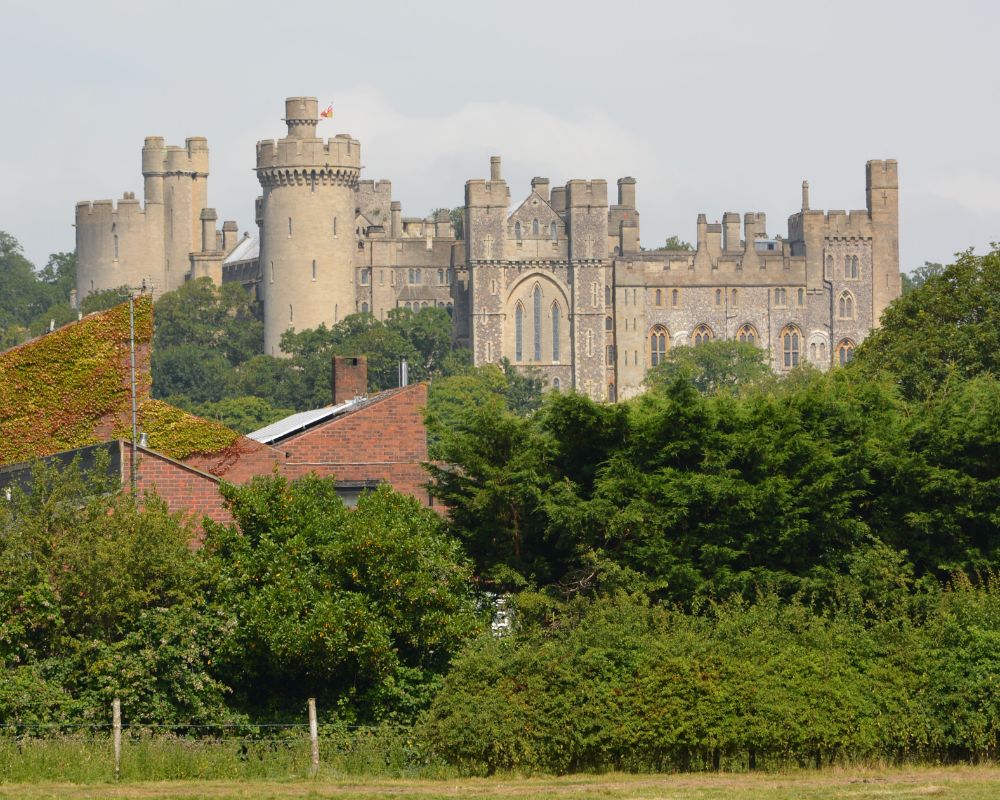
Dover Castle, a medieval marvel, has stood as a guardian over the English Channel since its foundations were laid in the 11th century. This grand castle, often hailed as the most famous castle in England, has played a pivotal role in the country’s history, symbolizing over 900 years of British resilience. Its strategic location on the cliffs overlooking the Channel has rendered it an impenetrable artillery fort throughout various epochs, from medieval times to the Napoleonic Wars and beyond.
The castle’s architecture, evolving since its conception in the 12th century, showcases the adaptive nature of English fortifications. From its early design under the auspices of the Holy Roman Empire to its expansion in the 16th century under King Henry II, each modification reflects a chapter in England’s storied past. Its transformation continued through Victorian times, embodying the elegance and grandeur of the era.
A lesser-known yet significant aspect of Dover Castle is its underground network. These tunnels, first dug during the medieval period, were expanded in the 18th century and again played a crucial role during World War II. Here, deep beneath the castle’s rugged facade, lies a labyrinth of secret wartime tunnels that once served as an operational headquarters and sanctuary for troops. These hidden passages offer a unique glimpse into England’s tactical ingenuity and the castle’s role as a defensive stronghold.
Today, Dover Castle transcends its role as a medieval fortress. It stands as a symbol of English heritage, a testament to the nation’s enduring spirit and adaptability. Visitors can explore the historic rooms, including the Great Tower and the opulent interiors that echo the lifestyle of medieval royalty and nobility. The castle’s gardens, carefully maintained to reflect their historical accuracy, offer a serene escape, allowing visitors to wander through the same grounds that kings and soldiers once trod.
Dover Castle is not just a relic of the past but a living, breathing monument. Its walls, steeped in centuries of history, continue to tell stories of bravery, strategy, and survival, resonating with visitors from around the globe. Whether you’re a history enthusiast or simply seeking to immerse yourself in England’s rich tapestry, Dover Castle stands as a complete guide to the nation’s medieval legacy and enduring spirit.
Hever Castle: The Childhood Home of Anne Boleyn
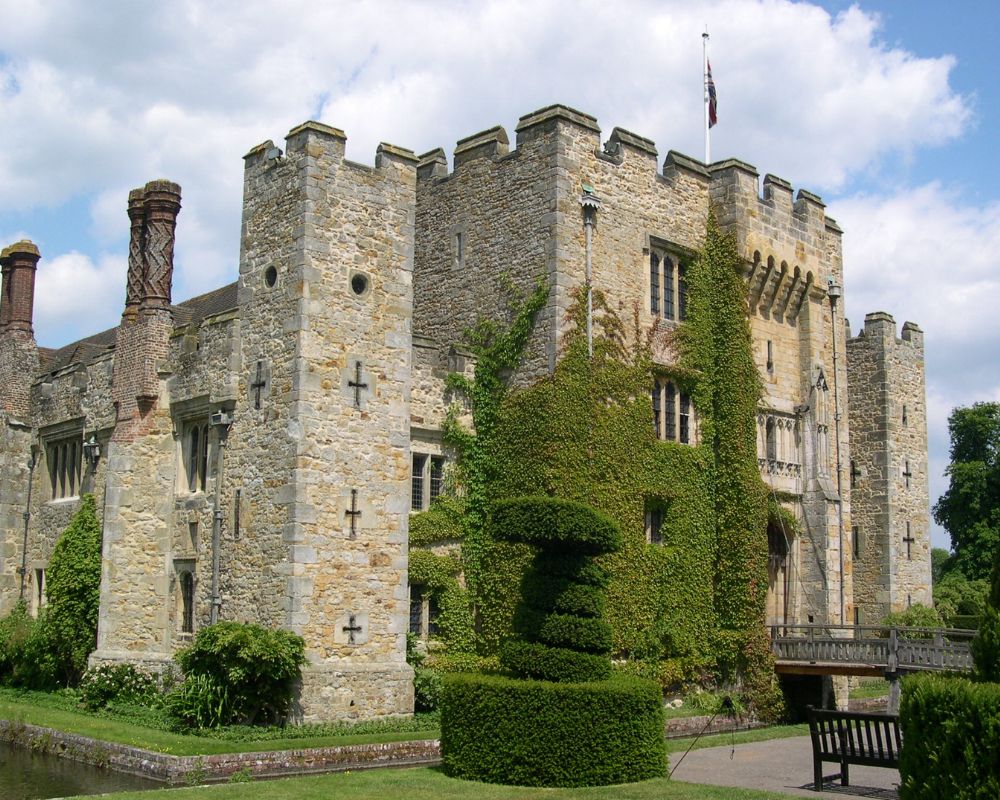
Nestled in the verdant landscape of Kent, England, Hever Castle emerges not only as a quintessential medieval castle but also as a pivotal chapter in the annals of English history. This 13th-century gem, enveloping visitors in an aura of history and romance, offers a vivid window into the life of Anne Boleyn, one of England’s most enigmatic historical figures. The castle’s striking architecture, characterized by its grand castle façade and fortified gatehouse, echoes the grandeur of medieval country houses, while its intricate interiors and lush gardens evoke the essence of a bygone era.
As you meander through its stately rooms and roam its expansive grounds, Hever Castle conjures images of young Anne Boleyn, whose early years here were laced with the intrigue and ambitions that would later define her. This castle, standing resolute through centuries of history, witnessed the formative years of Anne’s life, setting the stage for her eventual ascent to the throne as Queen of England.
The charm of Hever Castle extends beyond its historical significance. With its location near the meandering River Arun and its proximity to other famous castles like Walmer Castle and the iconic Thornbury Castle in the southwest of England, Hever offers a panoramic view into the rich tapestry of England’s noble heritage. The castle’s beautiful gardens, a testament to Victorian landscaping prowess, bloom in vibrant colours, creating a tranquil sanctuary that contrasts with the turbulent history it witnessed.
Hever Castle, transcending its role as a mere historical monument, represents a nexus of centuries-old stories where the whispers of the past mingle with the present. It’s a place where the echoes of Anne Boleyn’s footsteps resonate in the grand halls and along the corridors, a constant reminder of her indelible impact on English history. For visitors seeking a connection with the past, a stroll through Hever Castle is more than just a tour; it’s an immersive journey into the heart of medieval England, offering unlimited access to the legacy of one of its most famous residents.
Leeds Castle: A Castle in a Lake
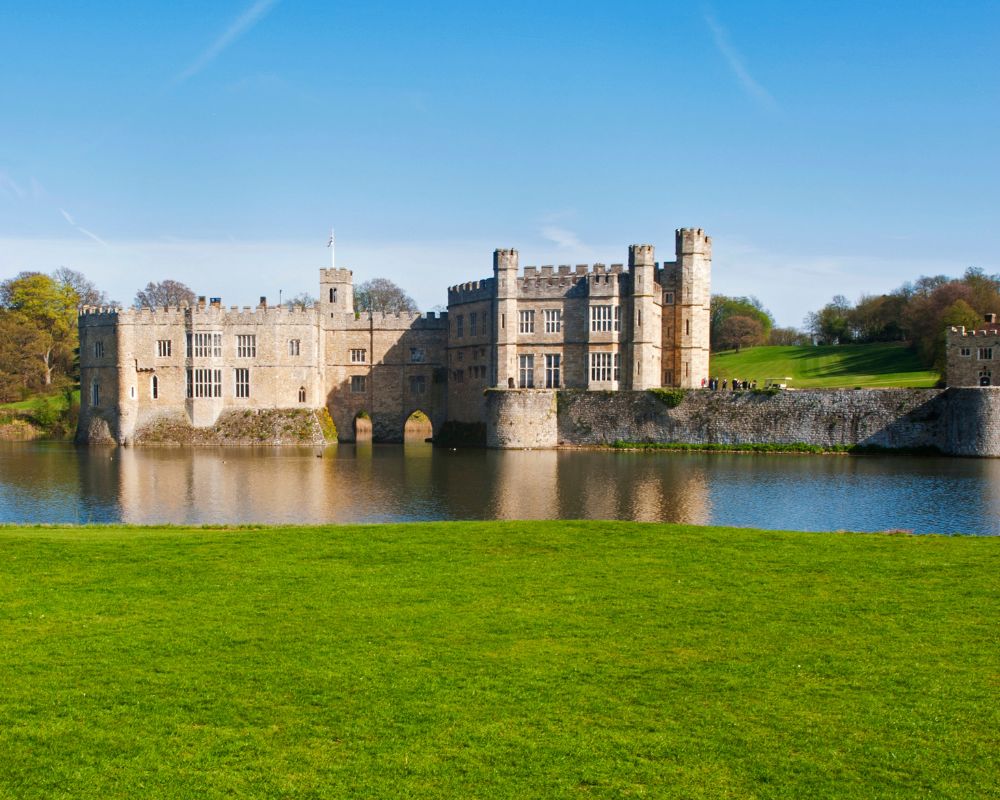
Leeds Castle, often hailed as the world’s most beautiful castle, stands majestically in the South of England, its splendour reflecting in the tranquil waters of its surrounding moat. This English castle’s storied history stretches over 900 years, making it a significant part of the tapestry of British heritage. Unlike the imposing Guildford Castle or the coastal Southsea Castle, Leeds Castle charms visitors with its picturesque islands set amidst a serene lake, evoking an atmosphere of peaceful grandeur.
As you wander through the castle, which rivals the architectural magnificence of Buckingham Palace, you’ll be transported back through centuries of history. Each room tells a tale, from the medieval times of King Edward to the grandeur of the 14th-century castle design. The staterooms, lavishly adorned and filled with artefacts, offer a glimpse into the lifestyle of the noble manor houses of England, akin to those in the Scottish Borders or the historic Corfe Castle.
Beyond its historical allure, Leeds Castle engages its visitors with a plethora of experiences. Falconry displays, reminiscent of those in the times of the Earl of Wemyss, bring the medieval past to life, while the sprawling parklands offer peaceful walks, evoking the days when lords and ladies strolled through their favourite castles’ gardens. For those seeking a unique perspective, hot air balloon rides are available, weather permitting, offering awe-inspiring views that rival the vistas from Castle Hill Rd. or Hever Road near the famed Alnwick Castle.
Today, Leeds Castle stands not just as a monument of the past but as a living, evolving estate. Creative projects and events are frequently hosted here, inviting visitors on short notice to engage with history and culture. From the tranquillity of low tide at the lake to the bustling activity during special events, Leeds Castle embodies the essence of modern times while preserving its historical integrity.
Leeds Castle continues to be one of the favourite castles in the United Kingdom, a testament to its enduring appeal across years of history. Whether you’re booking a history-filled excursion or seeking a spontaneous adventure, Leeds Castle awaits to offer an unforgettable experience.
Highclere Castle: The Real Downton Abbey
Nestled on the historic Broomfield Road, Highclere Castle is not just the real-life setting of the acclaimed TV series ‘Downton Abbey’; it is a venerable emblem of England’s aristocratic history. Initially established as a 14th century castle, Highclere has witnessed a remarkable transformation over the centuries, thanks to the visionary design of Sir Charles Barry and its association with notable figures like King Charles II.
As you stroll through the castle’s opulent interiors and gaze upon its meticulously manicured gardens, you embark on a journey through different eras. Each room narrates a unique story, revealing the castle’s evolution from a medieval noble manor house to a beloved icon of modern pop culture. The walls of Highclere Castle are imbued with tales of grandeur, resilience, and, at times, the crippling taxes and financial challenges that have threatened the preservation of such heritage sites.
Highclere’s captivating history extends beyond its architecture. The castle’s booking history is as rich and varied as the noble families that once called it home. From hosting elegant aristocratic gatherings to serving as a backdrop for one of television’s most beloved narratives, Highclere Castle has continually adapted its role and title through the ages.
Today, the castle’s ongoing preservation is a testament to the dedication of its custodians, ensuring that future generations can appreciate its grandeur. Visitors can explore this historical gem through a variety of events and tours, offering an immersive experience of the life of aristocracy. Highclere’s story is a celebration of the intersection between aristocratic heritage and modernity, serving as a reminder of the enduring legacy of England’s favourite noble manor houses.
As we witness Highclere Castle evolve, retaining its timeless charm and adapting to modern demands, it stands as a symbol of the enduring allure of England’s historical estates. Whether you’re a fan of ‘Downton Abbey’, a history enthusiast, or simply in search of a journey through England’s storied past, Highclere Castle offers an enchanting narrative set amidst the picturesque English countryside.
Oxford Castle: A Mix of History and Modernity

Nestled in the vibrant heart of Oxford, Oxford Castle stands as a beacon where ancient history and contemporary innovation converge. This architectural marvel not only boasts medieval roots but also thrums with modern vibrancy. Its imposing stone walls, a testament to centuries past, are now complemented by trendy cafes and eclectic art galleries, illustrating a journey through time.
At Oxford Castle, history is not just remembered; it is lived. Wander through the corridors where echoes of the past meet the hustle and bustle of the present. The castle’s grounds, once walked by medieval inhabitants, now host a curated selection of your favourite vendors, offering everything from artisanal crafts to local culinary delights.
Perhaps the most intriguing aspect of Oxford Castle is its ability to weave historical significance with present-day experiences. Imagine exploring the depths of medieval prison cells, their stories etched into the very stone, and then stepping out to savour gourmet cuisine at a nearby restaurant. This juxtaposition not only highlights the resilience of history but also the vibrancy of modern life in Oxford.
Oxford Castle is not just a destination; it’s an experience, a fusion of eras. It’s a place where history buffs and modern culture enthusiasts find common ground. Whether you’re drawn by the allure of the past or the pulse of contemporary life, Oxford Castle, on Broomfield Rd, offers a unique glimpse into a world where different timelines merge seamlessly.
Conclusion: A Timeless Adventure
In conclusion, the majestic castles of South England offer a captivating glimpse into the region’s rich history and architectural heritage. From the imposing walls of Windsor Castle to the enchanting gardens of Hever Castle, each fortress holds its own unique story waiting to be discovered. Exploring these grand structures provides a deep appreciation for the craftsmanship and resilience that went into their construction centuries ago. As visitors wander through the opulent rooms and towering battlements, they are transported back in time to an era of knights, royalty, and intrigue. Whether you’re a history enthusiast or simply seeking an unforgettable adventure, a visit to these castles is sure to leave an indelible mark on your travel memories.


